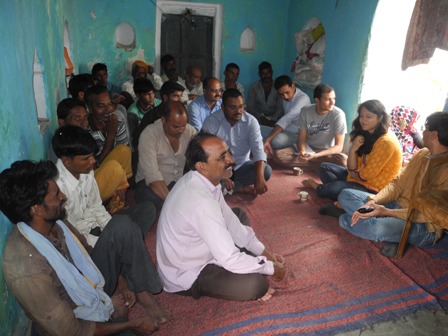A Journey to Orchha/TARAgram Yatra
 My Journey from New Delhi to Orchha in Madhya Pradesh was full of confusion, questions and challenges, which were completely leading me to an uncertain state of mind. However, my optimism of getting clarity soon yielded fruitful results, as I witnessed the finest practices of climate adaptation and sustainable livelihood which have given the local community in Orchha, a better living and have revolutionised them at the grassroots level.
My Journey from New Delhi to Orchha in Madhya Pradesh was full of confusion, questions and challenges, which were completely leading me to an uncertain state of mind. However, my optimism of getting clarity soon yielded fruitful results, as I witnessed the finest practices of climate adaptation and sustainable livelihood which have given the local community in Orchha, a better living and have revolutionised them at the grassroots level.
In the TARAgram campus, villagers at the TARAgram Mela proudly displayed their unique art, products and actively talked about the environmental jargon by using the mediums of folk music and dance; a point that the rest of the people in rural India will take time to understand.
COMMUNICATION MATTERS
The Radio Bundelkhand, a Community Radio set up by Development Alternatives in the TARAgram Campus has given the local community a new voice, to raise their local concerns on a broader platform and has helped to change the mindsets of the otherwise shy communities. The determination and confidence with which the local community reporters and managers interacted with us is worth applauding. It takes a lot of courage, even for skeptic professionals and trained journalists to interact at the professional level.
CREATIVITY UNCONSTRAINED
The visit to Shri Ram Raja Gaushala has been remarkable and inspirational. It clearly displays that, if right guidance is provided to the local community, one can definitely expect and create miracles. These are man-made miracles, put forth by the local women, who tirelessly and proudly display the new meaning to life.
The gaushala was established in 2004 with just 8 cows, now the number has risen to 102 and is still counting. This is a remarkable model of grassroot empowerment and finest use of creativity at a lower level. For me the “Gaushala” concept can be replicated in the rest of the country and can also be integrated with the “Swach Bharat” concept of the new government.
The global bodies often blame India for adding highest methane concentration to the atmosphere, owing to the millions of cows in the country. Despite knowing that cow dung is the best source of bio-energy, we have failed to captivate its benefits. Orchha’s gaushala concept is a model design and we can bring about a bio-energy revolution, if such small plants can be replicated in the rest of the villages in India.
FARMING MATTERS
The check dam concept, adopted by Development Alternatives with the local community is another remarkable achievement. It clearly shows the level of research and adaptive measures that have been taken to let the farmers continue with their agricultural practices and build their resilience.
Our interaction with the farmers is worth mentioning as it highlighted that the farmers completely dependent on agriculture are adopting measures that provide them maximum benefits, such as growing the appropriate crop in accordance with the quality of the soil and the availability of irrigation facilities. The approach adopted by farmers towards the climate change is an important lesson for those, who in their cozy rooms talk much about climate change but do nothing positive about it on the ground.
The TARAgram training center at Pahuj is yet another leap for Development Alternatives. The level of research and the adaptive measure being practiced over there are truly amazing. However, with the involvement rate of the local farmers being limited to just 10%, this center needs to adopt more localized approach to engage more and more farmers towards newer farming practices. The idea developed and executed by champion farmers with the support from Development Alternatives is innovative and inspirational in itself.
Building Bridges
In Kamhar Village, the timely intervention of Development Alternatives has revolutionised villagers, who now understand the importance of education for girls and women and they wholeheartedly, support Development Alternatives’ TARA Akshar Concept –‘A school for women’.
Besides education, these villagers are to some extent, aware about the paradigms of climate change and are capable to discuss the adaptive measures. The confident and proud villagers, even share the story of a CEO visiting their village and developing their village plan with them. It may not be a new thing for us, people visiting from the city. But for the people of Kamhar village, it was for the first time that any senior official sat amongst them for three hours, discussed their problems and facilitated in developing their village plan. Development Alternatives’ intervention in this village has guided them to a new future. People now understand various government schemes and are able to gain benefits from them.
Development Alternatives has given a new power to the people in villages and has given them a new chance to create a better future while keeping in mind climate resilient development. Today, the local communities in Orchha understand the concept of climate change to some extent and are well aware about the adoptive measures that need to be taken. But there are still many areas that have to be worked on and more localised approach is required to replicate this success rate in other parts of the state and India.
By Tawqeer Hussain.
“Tawqeer Hussain is a Delhi based Journalist, reporting for Australian Newspaper, Herald Sun and also contributing stories for The Hindu and The Citizen. He was one of the journalist on field visit to Orchha organised by Development Alternatives.”



Leave a Reply